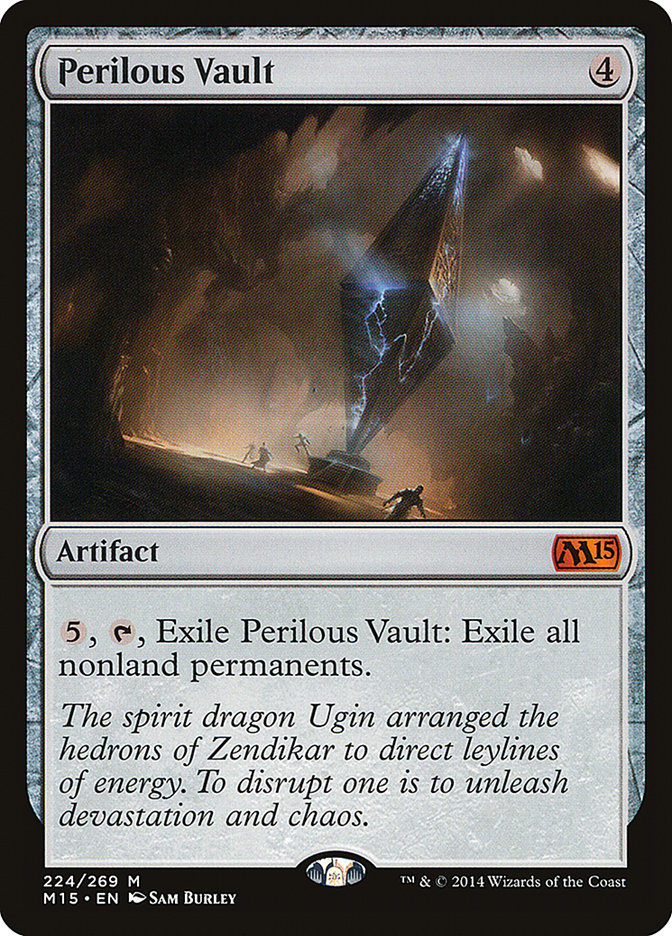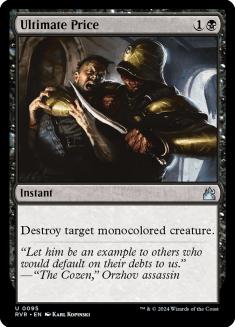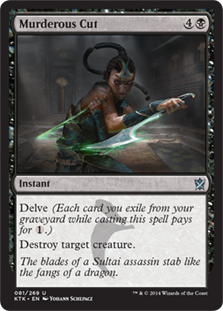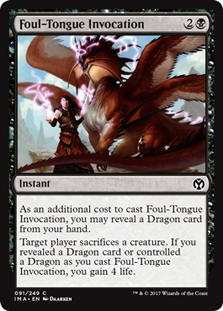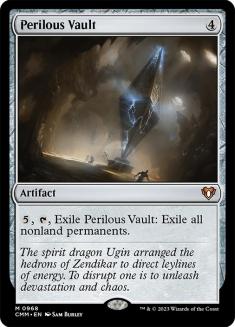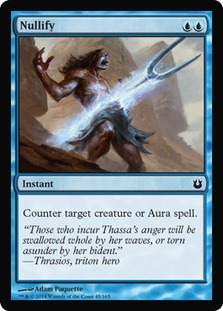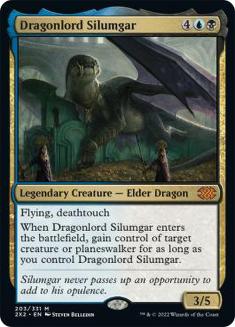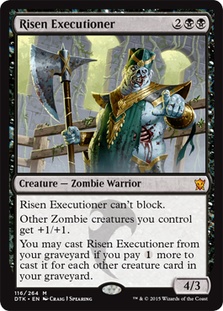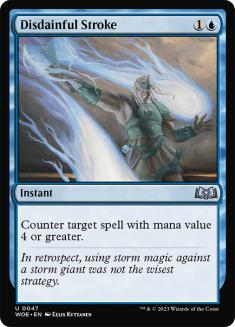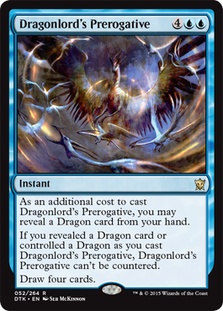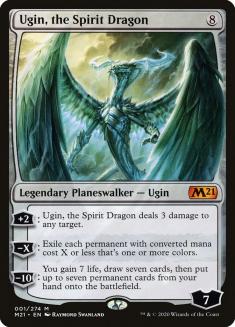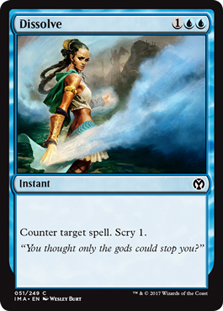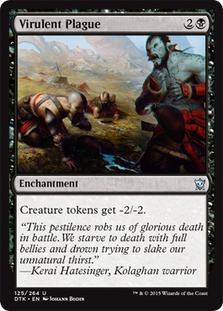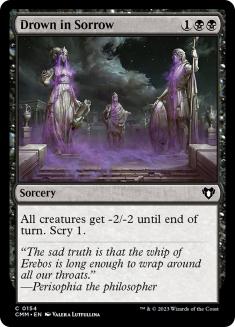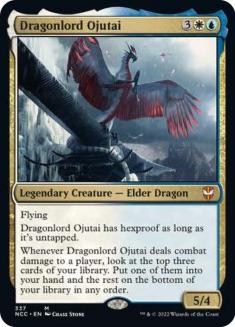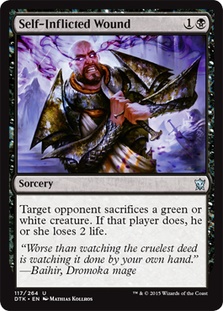Since my last article, I’ve been playing a lot with my
U/B Dragons concept, using Perilous Vault to a large amount of success. As I mentioned at the tail end of discussing the deck last week, I was interested
in working on a list with similar principles that utilized Dragonlord Ojutai. To make a long story short, everything fell into place once I did. I
understand that there has been a lot of productive discussion and analysis of Esper Dragons of the Pro Tour/Channel Fireball variety, but there are some
distinct differences and advantages of playing “Good Mana Dragons with Vaults,” and it’s my job today to convince you as such.
Creatures (5)
Planeswalkers (1)
Lands (28)
Spells (26)

The Mana
The largest draw to the deck conceptually is the mana. After seeing Bryan Raymer’s Mono-Blue Control deck and losing to myself with CFB Dragons numerous
times, there was a great deal of appeal to streamlining the mana to essentially just splash black. The reason for this, as I will detail in a moment, is
that Foul-Tongue Invocation is just plain worth it. By not being bogged down with the necessity of double black for Bile Blight and Hero’s Downfall as your
early interactive spells, you are more likely to be able to cast your spells on-curve, a critically important component for a control deck, especially one
that is interested in playing a creature on turn 5 to catch up. Although I was a big fan of Radiant Fountain in more aggressive matchups, moving to Ojutai
has required the inclusion of some Caves of Koilos, which do benefit your black spells, but more importantly, we can now play four copies of Haven of the
Spirit Dragon.
Haven of the Spirit Dragon is one of your largest edges in traditional mirror matches. By just playing two more functional Dragon cards in your deck, it is
far less likely that the first game will come down to decking, and due to how difficult it is to gain any kind of major initiative if both players have
functional draws, this small advantage in threat density is a big deal. Further, by playing two more “spell lands” to reduce flooding, we can comfortably
play 28 lands.
I am typically biased towards playing an additional land on average in my decks these days, but for control decks it is especially critical to never
stumble, as it can be difficult to catch up against the more aggressive draws in the format. Our card selection and threats are so powerful that it is easy
to use all of your mana when placed under pressure as long as we can cast our spells.
Getting double blue on the second turn is incredibly reliable, and we are forced into playing less enter-the-battlefield tapped lands to support Ojutai,
but it is worth mentioning that our mana may be “too good.” I mean this in the sense that it is probably not optimized and there may be room to make the
mana slightly worse to support the two glaring BB spells in our sideboard. Further, Crucible of the Spirit Dragon, as explored by Mike Flores and Patrick
Chapin in their Five-Color Dragon’s deck (which is awesome and does some things I’d like to try, but it’s ultimately is a different deck), is another card
that could be fit into the deck in some number of copies to push our mana advantage in the slower slanted matchups.
The Threats
I won’t continue to beat a dead horse, but Dragonlord Ojutai is incredible, and I think the time will come sooner rather than later that folks realize they
should just be playing four copies before messing around with any of the other Dragonlords. Gerry covered it well in his discussion on Esper Dragons, but
it’s worth reiterating: Dragonlord Ojutai creates a “tempo black hole” for your opponent. Once he enters play, your opponent is constantly forced to leave
up mana, and if they choose not to, typically one free hit is all that it takes for the game to snowball completely.
Often times, Icefall Regent functioned as little more than “Dragon Hand Enchantment – turn on my best spells” and that’s all it needed to be! The card did
almost functionally nothing, so it’s been no surprise how much more powerful the deck has felt when Ojutai joins the party.
I had two Ugins in my maindeck and a Dragonlord Silumgar in my sideboard for quite a long time before making the swap to one and one. This has changed for
two reasons: One is that with four copies of Haven of the Spirit Dragon and Anticipate/Dig Through Time, you will always both find and be able to put your
opponent into the relentless Ugin lock at the final stage of the game. Due to the Impulse effects, there will never be some kind of issue with Ugin being
at the bottom of your library. He is an incredibly powerful effect, but Foul-Tongue Invocation and Silumgar’s Scorn are so important to the strategy that
giving yourself the extra % of Dragons can often be vital to winning a game.
Secondly, it’s not like Dragonlord Silumgar is a slouch himself. Not only is he cheaper, and a Dragon, but his effect is extremely unique and can win games
in bizarre fashion whether it is through stealing too much tempo by taking your opponent’s only threat on turn 6, or by messing with any planeswalker plans
they may have had.
For now, I desire no changes to the threat suite.
The Spells
In my mind, the biggest question that should come up when looking at this deck is: “You’re basically splashing Foul-Tongue Invocation, is that really worth
it?” 100% yes. Foul-Tongue Invocation is one of those rare spells that has both applications in every matchup and isn’t sacrificing a drop of power for its
versatility. It is not only the best card for actually dealing with opposing Dragons, most of which have hexproof, but it is the strongest removal spell
against Abzan Aggro, heroic, and it still does a ton of work at buying time against Mono-Red’s token-heavy draws. An underrated aspect of modern
Constructed Magic is that lifegain is important. Life totals are much more frequently resources these days with the influx of powerful proactive threats.
Simply having a way in your 75 to gain life grants a lot of wiggle room towards pushing your strategy forward under pressure.
I frequently feel like I’m casting a Time Walk every time I’m playing an Invocation, and when coupled with Perilous Vault you’re often putting your
opponent in a tough squeeze that is nearly impossible to play optimally against.
Speaking of Perilous Vault, therein lies the other key difference between this deck and most other Dragon decks floating around. Let’s just make this
clear: Although Perilous Vault is slower and can be worse in many spots in which Crux of Fate performs, Perilous Vault actively fights the cards that
actually beat your strategy. With Bant Megamorphs picking up in popularity and the Den Protector/Deathmist Raptor combination being incorporated into
several different types of shells, Crux of Fate continues to decline in effectiveness. Vault, on the other hand, actually allows you to grind through these
recursive threat engines while more importantly allowing you to dictate the pace of the game. At any point in which you stick Perilous Vault, particularly
against control, you control the flow of action and can choose to trade life for time to cast your draw spells before blowing up the world and untapping
with all of your defenses up.
Dragonlord’s Prerogative is another card that I touched on previously, and not much has changed other than that I wanted to decrease my curve overall.
Having a ton of sixes in your deck can bog you down quickly even though it is immensely powerful. After playing with it more, however, I can firmly say it
is just better than Jace’s Ingenuity.
Anticipate is a card that I still don’t like, but I’ve come around to the fact that it performs a vital role. Now that we have “The Ojutai effect” in our
deck, just being able to find it as fast as possible and jam on turn 5 gives us a great proactive element. Anticipate also helps with powering up Dig
Through Time and filtering for our most high-impact interactive spells in the first game. It is worth noting in sideboard scenarios, I’ve often been
cutting an Anticipate on the draw against aggressive decks, as it can be difficult to find the time to cast it.
The rest of the outliers are largely due to cost restrictions. Nullify has always been great if you could cast it, and now you can. It is also another
spell that can cleanly trade for Dragons and Rhinos. Ultimate Price is the second best removal spell we can cast. It is a little narrow and significantly
worse than Bile Blight in our tougher matchups (red), but it is still an important piece of the puzzle.
Most would think that the major trade off within the deck is the removal of Hero’s Downfall, but I just haven’t found that to be true thus far. There are
an overwhelmingly low amount of planeswalkers in the format right now, and the reason for that is simply how effective the Dragonlords are against them.
There are few incentives to be playing Xenagos and Elspeth when they just get eaten by big dumb Dragons that are hard to interact with. This favors us, as
Downfall is hard to cast and not extremely effective, so we don’t have to go out of our way to play it. Further, Perilous Vault helps to pick up the slack
here against the more expensive ‘walkers that could actually give us fits. The only major issue I could see with this line of thinking is a big resurgence
in Ashiok, Nightmare Weaver, but I don’t think the format has reached that point just yet.
Matchups and Sideboarding
VS Esper Dragons
Out:
In:
The most important thing for playing this matchup pre-sideboard is to be patient and hit your land drops. You have a sufficient amount of answers, and the
best chance they have of winning is to stick Ugin while you do not have Perilous Vault in play or Dragonlord Silumgar in hand. If you do find yourself with
a Vault in play and with more cards in library, there is absolutely zero incentive to make a move in the game other than to keep hitting your land drops.
That being said, the primary route to victory does not need to involve decking as they have very few ways to interact with your Ugin if you prioritize your
counterspells properly. It is typically best to not fight on small exchanges for cards early, rather to play a game that is designed around exhausting
their threats and protecting yours.
In sideboard scenarios, Risen Executioner lets you push into a far more proactive role. As long as you can deal with a Dragon onboard and they are off Ugin
mana, just jam Executioner aggressively as there is little they can do about it other than buy time against the inevitable.
This matchup is quite favorable, and it is one of the biggest draws to playing this strategy.
VS Mono-Red
Out:
In:
This matchup is all about winning short-term tempo exchanges. Trade and use your mana as aggressively as possible to protect your life total. There is no
shame in casting Foul-Tongue Invocation for a Goblin token and four life. You will notice the lack of Bile Blight the most here, but if you are able to
steal game 1 off a quick Dragon, then you’re a big favorite. Sideboarding is completely about removing expensive cards for high impact effects like
Virulent Plague and Drown in Sorrow. The fact that Drown can be difficult to cast on turn 3 is felt, but thankfully, Anticipate picks up some of the slack.
VS Bant Megamorph
Out:
In:
Perilous Vault is your best card in the matchup, and in the first game in particular, they have little that punishes you for setting up by tapping out for
it. Dragonlord Ojutai is much harder to control since it is surrounded by a slew of green creatures, but if you can counter it and never get blindsided for
a ton of damage by Surrak, the Hunt Caller, then the first game is easy. Sideboard games get significantly more difficult as they now have countermagic and
are playing a firm aggro-control game. Keeping the board clear of relevant threats early on is of utmost importance. The midgame will typically devolve
into a key turn where you must stick Vault while fighting through one of their disruption spells with Thoughtseize or Silumgar’s Scorn. If you can
accomplish this, then you can often stabilize and pull ahead with your top end, but it is entirely possible for them to get under you and use their
protection to close the game out. Never letting your Dragonlord Ojutai run into a Valorous Stance is incredibly important.
VS Abzan Megamorph
Out:
In:
You are operating on almost solely the same principles as Bant Megamorphs, except Game 1 is a little bit tougher since they have Thoughtseizes. This
incentivizes you to tap out aggressively for your best spells at every opportunity you can. Secondly, Negate is a much better plan for fighting discard.
This is in contrast to Thoughtseize for clearing out opposing countermagic.
VS Heroic
Out:
In:
It is amusingly notable that this is only matchup I think it is correct to shave a Dragonlord Ojutai. He doesn’t really come under any pressure, and we
want to minimize our expensive cards. Dragonlord Silumgar is also a great follow up to take their best creature if you are able to overload their mana on
end step. This should be a matchup you want to play, as Perilous Vault and Foul-Tongue Invocation shine extremely brightly and neither cares about Gods
Willing or Ajani’s Presence. After sideboard we get more good removal, including six edicts. Normally, I would consider Drown in Sorrow rather poor in
these matchups, but between Monastery Mentor in Ross Merriam’s winning list last weekend and your high number of edicts, we want to diminish their “go
wide” plan as much as possible to clear a path to kill their invested creature.
VS Abzan Aggro
Out:
In:
It would appear to be that Abzan Aggro is on the decline, which is probably for the best since our sideboard doesn’t do much to impress here. Wound and
Foul-Tongue are both great, but this matchup can still be difficult if they find an angle to get under you, particularly on the play. Otherwise this is
just a straightforward battle of being as efficient as possible and landing an early Dragon that will force them to slow down and let you transition into
the lategame. Be wary of Elspeth from the sideboard and its potential to come down and eat your Dragonlord Ojutai if you are overzealous, especially if
your opponent appears to be playing a more timid game with several cards in hand.
There are many more decks and avenues to explore in Standard, but I hope that very fact encourages you to pick up Vault Dragons. Between having an
extremely powerful proactive plan utilizing the best threat in the format and the ability to handle any type of midrange strategy with Perilous Vault
coupled with honest actual counterspell and a wide range of inevitability tools, this deck has game and a plan against everything.

